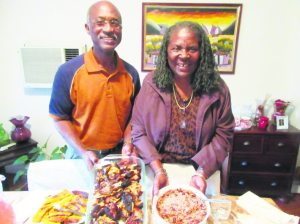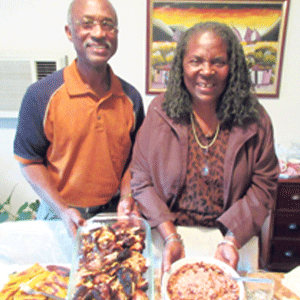Jamaican cooking in Westbury
Bringing the rich vibrant culture of Jamaica to American audiences is a goal of Westbury businessman Patrick Payne. To that end, Payne, who is also an adjunct professor and philanthropist, is offering The Jamaican Christmas Special on Saturday, Dec. 19, an all-day event to be held at Westbury High School. The program begins at noon with a traditional Jamaican gift and cultural expo and a Jamaican holiday cooking workshop, culminating in a concert at 7 p.m.
To learn more about this event and the cuisine of Jamaica, I visited Payne at the Westbury home where he and his family have lived for 13 years. His neighbor, Daphney Maylor, a retired pediatrician who has lived in Westbury for 38 years, joined us.

“We like the mix and character of Westbury,” said Payne. “It is strategically located near the airport and sufficiently suburban.”
Both families stay closely connected to their homeland through frequent visits, cultural events and, certainly, the food. Payne maintains a large vegetable garden in his backyard where he grows callaloo, for a popular vegetable dish that is served throughout the Caribbean, as well as Scotch bonnet, the fiery peppers used in Jamaican jerk sauce. Scotch bonnet, amongst the hottest chili peppers in the world, has a heat rating of 100,000 to 350,000 Scoville units, the scale for measuring intensity of peppers (jalapeno peppers rate from 2,500 to 8,000). Be warned.
Lunch at the Payne house included typical Jamaican dishes of jerk chicken, rice and peas, cooked green bananas, salad and, for dessert, Maylor’s fabulous Jamaica Black Cake.
The savory rice and peas was an artful combination of rice, red beans, coconut milk, fresh thyme, scallions, salt and the ubiquitous Scotch bonnet, also called country pepper.
Jerk chicken is a quintessential Jamaican dish in which meat is dry rubbed or wet marinated with a very hot spice mixture of allspice—called pimento in Jamaica—and, you guessed it, Scotch bonnet peppers. Other ingredients may include cloves and nutmeg, thyme, garlic and brown sugar. Jerk spice tells the story of the African diaspora. It is said to have originated in the mountainous eastern side of Jamaica that was populated by African slaves who escaped there when the British invaded the Spanish colony of Jamaica in 1655. Those slaves were Ashanti of West Africa and they developed the spice and the cooking technique, originally over pit fires. Now it is cooked in steel drums over hardwood charcoal. Payne says that much of the Jamaican food culture is African in origin, citing the traditional dessert called “duckunoo” or “tie-a-leaf” where a sweet cornmeal batter is wrapped in banana leaves and steamed.
There was no country pepper in the cake, which was dense and delicious. Maylor says that baking is something that she likes to do. “I’m so glad my grandmother taught me these things,” she said. She doesn’t follow a recipe or measure when she cooks and was lamenting the fact that her children don’t know how to make the cake. I was able to pull the ingredients out of her, to help the preservation of this traditional Jamiacan recipe.
 Jamaica Black Cake
Jamaica Black Cake
Makes 3 to 4 nine-inch round cakes
Dried Fruit:
2 pounds raisins
1 pound currants
½ pound prunes or dates
¼ pound cherries
½ pound mixed peel
½ cup rum (40 proof Jamaican rum)
½ cup wine (Manischewitz)
Batter:
1 pound butter
1 pound brown sugar
1/2 cup burnt sugar
1 teaspoon cinnamon
1 teaspoon nutmeg
¼ pound chopped nuts (optional)
1 Tablespoon vanilla essence
1 Tablespoon almond essence
1 pound flour
1 teaspoon baking powder
1 teaspoon baking soda
12 eggs, separated
juice and rind of one lemon
Blend half of total fruits in blender with rum and wine (1/2 cup of each). Then place remaining fruits with rum and wine (half cup each). Mix blended and unblended fruit and place in glassware or jar; cover and allow mixture to steep for three weeks to three months, or longer.
When ready to bake cake, cream butter and brown sugar well. Then add the chopped nuts (optional), burnt sugar, cinnamon, nutmeg, vanilla and almond extracts. Add the fruits to the butter and sugar mixture. Add the flour, which has been combined with the baking powder, baking soda.
Separate the eggs in two bowls. Beat egg whites with wire whisk attachment at highest speed ; add lemon zest before the meringue is formed. Add beaten whites to batter. Beat egg yolks with juice of one lemon and add to mixture.
Grease and flour three or four 9 inch round by 2 ½ inches high).
Fill to one inch from the top.
Bake in 300 degree oven for 2 to 3 hours. Test for doneness by piercing the center with a knife; knife should return clean when done. Cool cakes before removing from pan.
These cakes can be stored for up to 4 months. Wrap in plastic wrap and occasionally moistened with a run/wine mixture—about one-quarter cup.




























